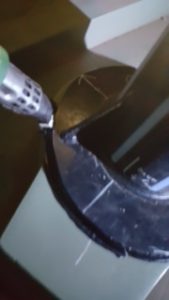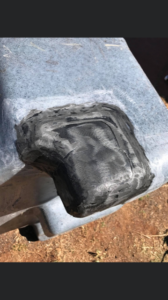Plastic Welding
 Using plastic welding, two plastics can be welded together.
Using plastic welding, two plastics can be welded together.
If you have a cracked plastic item, then welding the damaged pieces together is a stronger option than using glue.
Plastic welding is the process of creating a molecular bond between two compatible thermoplastics.
Welding offers superior strength and often drastically reduced cycle times to mechanical joining (snap fits, screws) and chemical bonding (adhesives).
Welding of Thermoplastics

Professional, plastic welding of thermoplastics is accomplished in three sequential stages.
1. surface preparation
2. application of heat
3. pressure, and cooling.
Production of a good quality weld does not only depend on the welding methods, but also weldability of base materials.
There are different types of plastics. We must know which one we are working with in order to find the exact welding material to be used.
Most plastics today used in manufacture are stamped with plastics identification codes. However, where this identification is not present, a welding test is required to ID the material to be welded.
Plastics surface preparation involves ensuring all soils are removed.
Any paints, oils, greases and even UV degradation must first be removed prior to welding.
All painted surfaces should also be cleaned right back to the original material.
Establishing a weld between flexible materials issues new requirements for the clamping technology.
Necessary force needs to be exerted exactly at the welding zone due to the flexibility that prevents transmission of torsion moments.
Types of Plastic Welding Repairs
 Picking the right plastic adhesive can make you wish you’d majored in chemistry.
Picking the right plastic adhesive can make you wish you’d majored in chemistry.
Welding is arguably the better method for fusing two plastic components for plastic repairs for:
- water tanks
- valve handles
- motor bike parts
- vehicle parts
- kayaks
- rafts
- anything plastic
- plastic repair
Plastic Welding Techniques
There are many plastic welding techniques.
Here are just 10 examples, to give you an idea of the many options available.
1). Extruded-Bead Sealing
A bead of the same materials is extruded between two sections and then the two sections are immediately pressed together. The heat in the extruded bead is sufficient to cause it to weld to the adjacent surfaces.
2). Friction Welding
Rapid angular oscillations are applied to heat the plastic parts to be joined. This variation of the spin welding process is used for parts that are not symmetrical about an axis of rotation. The equipment must be programmed to stop when the parts are properly positioned for joining.
3). High Frequency Welding
A method of welding plastic components in which the surfaces to be joined are heated by contact with electrodes of a high frequency electrical generator.
4). Hot Gas Welding
Welding guns for plastics contain an electrically or gas heated chamber through which a gas, usually dry air or nitrogen, is passed. The heated gas is directed at the joint to be welded, while a rod of the same materials as the thermoplastic being welded is applied to the heated area.
5). Hot Plate (Hot Tool) Welding
Two plastic surfaces to be joined are first held lightly against a heated metal surface, which may be coated with PTFE to prevent sticking, until the surface layers are melted. The surfaces are then quickly brought together and held under light pressure until cool.
6). Induction Welding
A conductive metal insert is placed on the interface of two sections to be joined. While applying pressure to hold the sections together, the welder heats the metallic insert by means of a high frequency generator until the surrounding plastic material is softened and welded together and then cools the joint.
7). Laser Welding
The two parts are put under pressure while a laser beam moves along the joining line. The beam passes through the first part and is absorbed either by the second part or an absorbent coating, generating enough heat to soften the interface and creating a permanent weld.
8). Solvent Welding
The welder applies a solvent capable of softening the surfaces to be joined and presses the softened surfaces together. Adhesion is attained by means of evaporation of the solvent, absorption of the solvent into adjacent materials and/or polymerisation of the solvent cement.
9). Spin Welding
Plastic components of circular cross section are rotated, one part in contact with the other, until sufficient heat is generated by friction to cause a melt at the interface, which solidifies under pressure when rotation is stopped to weld the articles together. The process can be performed manually in a drill press with suitable chucks to hold the parts, or can be automated by adding devices for feeding, timing, controlling stroke and pressure of the press, and ejection.
10). Ultrasonic Welding
A method of welding or sealing thermoplastics in which heating is accomplished with vibratory mechanical pressure at ultrasonic frequencies (20 to 40 kc.) Electrical energy is converted to ultrasonic vibrations by a transducer, directed to the area to be welded by means of a horn, and localised heat is generated by the friction of vibration at the surfaces to be joined.
Give us a call or contact us with any questions you have about your application
- We Come To You
- All Types & Size Poly Tank Repairs
- High Quality Repair Guarantee
- 20+ Years Of Experience
- Save $$$ On Costly Replacements
"Our ability to customise, problem solve and fabricate individual parts for any job is second to none. "
Shane Saunders
APE Plastics
Amalgamated Plastic Engineering
One off tanks for all industries including Motor Homes, Engineering, Marine, Agriculture, Construction, Architectural, Aircraft and more.
Quick Links
- Poly Tank Fabrication
- Custom Fabrication
- Poly Tank Repairs
- Plastic Welding
Contact
website by ToowoombaWebDesign


